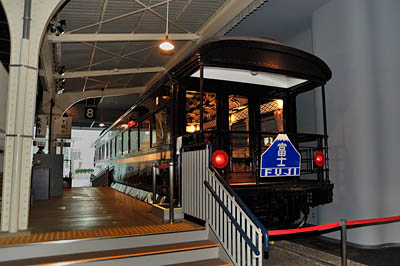
Passenger Car
Class
|
Typical limited express coupled observation car of the prewar era. (Ma = Weight 42.5-47.5 ton, I = First passenger class, Te = Observation car) |

|
|
Japan's first observation car was owned by the Kyushu Tetsudo Co and was imported from the US. BuKuTo-1,
and was exclusivly used for distinguished guests. The first Japanese limited express was started during June 1912, and two classses of six observation cars were produced as the basis for BuKuTo-1. There were five Class SuTen-9020s and one Class of one SuTen-9025, and, they were coupled to regular trains for the first time. Afterward, in 1923, five Class OTen-28070s, and in 1930, three Class SuITe-37000s and two Class SuITe-37010s, in 1931, two Class SuITe-37020s, in 1938, two Class SuITe-37040s, for a total of about 20 observation cars were manufactured during pre-WW2. They all had triple axle trucks and their appearance was based on the American open deck style observation car. Open deck observation cars, were active, as the stars of Tokaido and Sanyo arterial lines limited express, until electric cars appeared during 1960. Class MaITe-39, and preserved No.11 (1930 - 1962) The MaITe-39, as now found in the museum, was manufactured at the Oi workshops during 1930 as SuITe-37010. At that time, two Class SuITe-37010s were produced as No.37010 and 37011. After it's appearance, the SuITe-37010 was coupled to the tail of the limited express "Fuji" and was active between Tokyo and Shimonoseki on the Tokaido, Sanyo line. Around that time, there was a ferry connection from Shimonoseki to the Asian continent, as well as, to Europe via rail. Therefore, Fuji's observation car was deemed in good order as an international train. According to the October 1930 time table, the first down-train on Fuji's schedule was ; Tokyo 13:00 - Nagoya 18:57 - Osaka 22:05 - Hiroshima 04:43 - Shimonoseki 08:50. And then it departed at 10:30 from Shimonoseki, via ferry, to Pusan, in Korea, under Japanese control at that time. At that time, the Japanese railway had three passenger classes, but Fuji ... did not accept a 3rd class car .... Fuji had a 2nd class seat car, one 1st class sleeping car, two 2nd class sleeping cars, a dining car, and an observation car. (3rd class was accepted after 1934). An observation car, was for the exclusive use of first class passengers only.
In 1930, the fare between Tokyo and Shimonoseki (about 1,100km) was 9 yen-78 sen for 3rd class. On the same section, it also took Fuji's 1st class sleeping car (lower) with the observation car, the cost was 43 yen - 84 sen. Currently (2009) between Tokyo and Shimonoseki the fare is 12,810 yen (130 US$), and if taken on the Shinkansen's Green-Car (1st class), it requires 27,500 yen (283 US$). Assuming the base fare is the same, and using the converted Fuji's 1st class cost in 1930, it would now be 57,422 yen (590 US$). In those days, few pepole used Fuji's observation car, as the upper class was not large. SuITe-37010 was basically the same model as the SuITe-37000, but the interior decoration was purely in the Japanese "Momoyama" style. (Japanese decoration during the 16th century). So, it particularly gained popularity with foreign passengers. Other observation car's interior decoration was in the western-style. An original SuITe-37010's interior arrangement as seen from the rear consisted of ..... the observation deck, the observation room, the conversation room, the division room, the server room, the washroom, the restroom, the conductor room and doorway.
During the same year, SuITe-37010 No.37010 and 37011 were renamed to Class SuITe-39 No.1 and 2. No. 1 received damage from bombing during the war, but both cars survived. After the war, they were not requisitioned by the allied military, and they were remade for regular limited express use. During 1949, SuITe-39 No.1's interior decoration was remodeled to simple western-style from the Japanese style, and was renamed to the Class MaITe-39 No.1. SuITe-39 No.2 was restored to the original "Momoyama" style and was named the Class MaITe-39 No.11. Around that time, SuiTe-38 No.2 (1930 built ex- Class SuITe-37000 No.37001, was renamed to the SuiTe38-2 during October 1941) was also transferred to Class MaITe-39 and numberd 21. The Class MaITe-39 had a total of three cars and were numbered No.1, 11 and 21. During March 1949, after the war, they were used as the first limited express "Heiwa (Peace)". No.1 and 21 were transferred to the "Tsubame (Swallow)" from 1950, but No.11 went into reserve. Their seat arrangement was changed and a selling booth was installed. During 1953, air conditioners were installed. During 1956, No.1 and 21 were changed to a different green color and were transferred as the new colored limited express "Tsubame" and "Hato (Dove)". But, the spare car No.11's color was not changed. During 1960, the class name was changed to Class MaRoTe-39. During the same year on the 31st of May 1960, all of Tokaido's locomotive limited express were replaced by electric car trains, and all observation cars were retired from regular service. During 1962, MaRoTe-39 No.1 and No.21 were scrapped. During the 90th anniversary of railroads in 1962, the MaRoTe-39 No.11 was displayed at the Ome Railway Park as the original model MaITe-39 No.11. However, MaITe39-11 went into ruin during the following years because of its poor state of preservation.
MaITe39-11's restoration work was done at the shops of Oi works during August 1999. But the original interior decoration "Momoyama" style couldn't be restored, so all interior decoration was removed. Afterwards, it was kept at the JR-East Tokyo General Rolling Stock Center. When MaITe39-11's exhibition was decided at the museum, "Momoyama" style interior decoration was restored as authentically as possible. And it was exhibited at the museum during October 2007. |
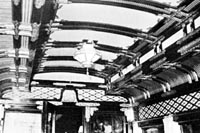 The Original interior, during 1930s (1940s ?). | 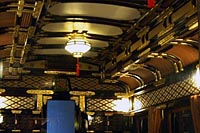 The later restored interior, during Apr 2009. |
How were the originals restored ? Please compare them.
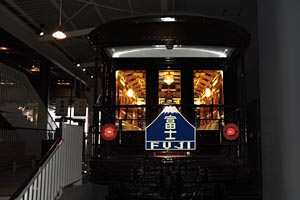
| 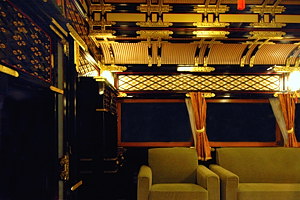
|
Restored Momoyama style interior.
Introduction |
Go to Top |